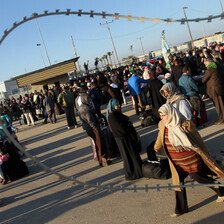The Electronic Intifada Gaza City 23 December 2014

The Shujaiya district of Gaza City on 20 December.
APA imagesPalestinian journalist Muhammad Daher did not live to see the birth of his son and will never see his one-year-old daughter grow up.
A financial editor for Al-Resaleh newspaper, the 27-year-old father and husband died after being injured during Israel’s brutal assault on the Shujaiya district of Gaza City this past summer.
His wife, Shaima, recalled that their three-story house collapsed on top of them when Israeli occupation forces attacked the area with heavy tank shelling on 20 July. “I was stuck under the house, under a pillar,” she told The Electronic Intifada. “I was pregnant at the time, and I really don’t know how I survived.”
Muhammad was transferred to the nearby al-Shifa hospital, where he succumbed to his wounds ten days later — on 31 July. Shaima was trapped next to her injured husband for six hours before being rescued by Palestinian medics. Three more of their relatives died under the rubble of the home, she recounts.
Muhammad’s sister, Bisan, just eight years old, was also stuck under the rubble and was badly injured by shrapnel.
The United Nations monitoring group OCHA estimates that 2,257 Palestinians were killed during Israel’s 51-day summer onslaught, including at least 1,563 civilians. Some 100,000 people are still displaced; they are now living in schools, temporary shelters or with host families across the coastal enclave, which has been under tight Israeli siege since 2007.
“Friends all loved him”
Shaima recalled that Shujaiya “was almost completely empty at the time” when Israeli forces attacked. “Thirteen of us were living in the house, and three stories came down on top of us,” she said.
She describes her late husband as a loving father and husband, dedicated journalist and “a loved man, who helped everyone he could. Neighbors and friends all loved him very much.”
In addition to his five years of work at Al-Resaleh, Daher printed a regular newsletter on the local economy.
He was one of at least sixteen journalists killed by Israel during the assault – dubbed Operation Protective Edge – and dozens more were injured or targeted. According to the watchdog group Reporters Without Borders, the Israeli-occupied West Bank and Gaza Strip is second most deadly place in the world for journalists.
According to statistics provided to The Electronic Intifada by the Gaza Centre for Media Freedom, at least fifteen Palestinian journalists were killed during the summer war.
Simone Camilli, an Italian photojournalist employed by the Associated Press, was also killed, bringing the total to sixteen. On 13 August, Camilli died with Palestinian fixer Ali Abu Afash when an unexploded ordnance left behind by Israeli forces exploded in the Beit Lahiya area of the northern Gaza Strip.
Though such killings took place in several areas across the strip, at least four of the slain press workers (including Daher) were killed in Shujaiya. For journalists, it was one of the most dangerous areas in Gaza.
Khaled Hamad, a 25-year-old videographer, was killed by Israeli shelling in Shujaiya on the same day as Daher.
Cousins Rami Rayan and Samih Rayan, respectively employed by the Palestinian Network and Al-Aqsa TV, were killed by Israeli shelling in Shujaiya on 31 July.
Massacre
Yet the slaughter in Shujaiya was not limited to journalists.
Israel attacked Palestinians across Gaza from land, air and sea, while Palestinian armed groups responded with rocket fire into the south of present-day Israel and against Israeli military positions.
Near the boundary line between Gaza and present-day Israel, Shujaiya was particularly devastated by Israeli attacks, resulting in accusations of a deliberate massacre of civilians. Months after a ceasefire was reached on 26 August, large swathes of the district, like much of Gaza, remain entirely destroyed.
A recent donor conference raised $5.4 billion for Gaza’s reconstruction, but, as The Electronic Intifada has previously reported, nearly half of that will be used to fill gaps in the West Bank-based Palestinian Authority’s budget.
The amount of construction materials allowed into Gaza in November only “constituted 13 percent of the October 2013 level, which represents less than 30 percent of the materials imported before the blockade” began in 2007, according to Shelter Palestine, a humanitarian aid body.
Walking through Shujaiya, homes, schools, mosques and a hospital are still razed beyond recognition. Most buildings still standing are pockmarked with bullet holes and bear the signs of tank shell damage.
Amid the mangled steel and concrete remains of Palestinian homes there are toys, prayer mats and other personal belongings still visible. Signs detailing the contact information of homeowners have been placed atop the massive mounds of rubble.
“I named him after his father,” Shaima said of her newborn son. “He’s only two months old now, but I hope he will grow up to look like his dad.”
Patrick O. Strickland is an independent journalist and regular contributor at The Electronic Intifada. His reportage can be found at www.postrickland.com. Follow him on Twitter: @P_Strickland_.





